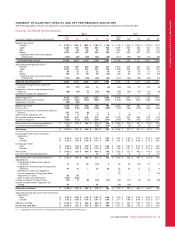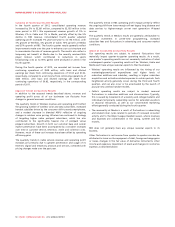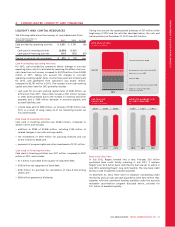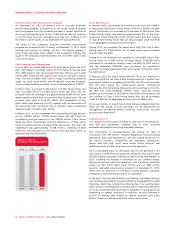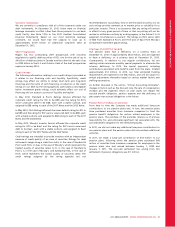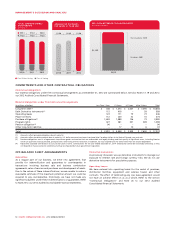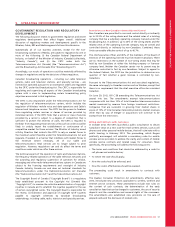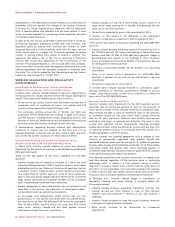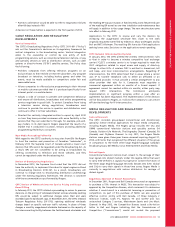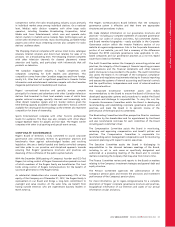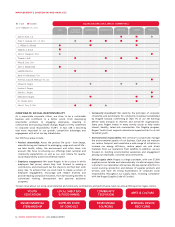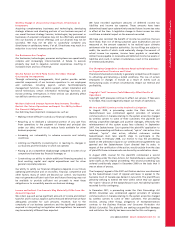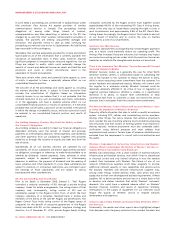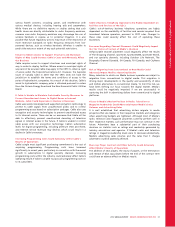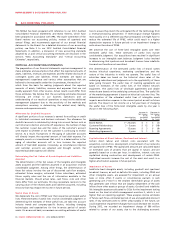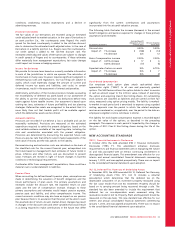Rogers 2012 Annual Report Download - page 63
Download and view the complete annual report
Please find page 63 of the 2012 Rogers annual report below. You can navigate through the pages in the report by either clicking on the pages listed below, or by using the keyword search tool below to find specific information within the annual report.
MANAGEMENT’S DISCUSSION AND ANALYSIS
• Parties to arbitration would be able to refer to negotiation failures
after 60 days instead of 90.
A decision on these matters is expected in the first quarter of 2013.
CABLE REGULATION AND REGULATORY
DEVELOPMENTS
Vertical Integration
The CRTC’s Broadcasting Regulatory Policy CRTC 2011-601 (“Policy”)
sets out the Commission’s decisions on its regulatory framework for
vertical integration in the broadcasting sector. Vertical integration
refers to the ownership or control by one entity of both
programming services, such as conventional television stations, or pay
and specialty services as well as distribution services, such as cable
systems or direct-to-home (“DTH”) satellite services. The Policy does
the following:
• Prohibits companies from offering television programs on an
exclusive basis to their mobile or Internet subscribers. Any program
broadcast on television, including hockey games and other live
events, must be made available to competitors under fair and
reasonable terms.
• Allows companies to offer exclusive programming to their Internet
or mobile customers provided that it is produced specifically for an
Internet portal or a mobile device.
• Adopts a code of conduct to prevent anti-competitive behaviour
and ensure all distributors, broadcasters and online programming
services negotiate in good faith. To protect Canadians from losing
a television service during negotiations, broadcasters must
continue to provide the service in question and distributors must
continue to offer it to their subscribers.
• Directed the vertically integrated entities to report by April 2012
on how they have provided consumers with more flexibility in the
services that they can subscribe to through, for example, pick-and-
pay models. In its April report, Rogers presented the results of a
market trial it conducted in London, Ontario providing additional
programming flexibility to consumers.
New Media Proceeding Follow-Up
With regard to the CRTC’s authority to levy a tax from ISPs like Rogers
to fund the creation and promotion of Canadian “webisodes”, in
February 2012 the Supreme Court of Canada upheld a lower court
decision that ISPs cannot be regulated under the Broadcasting Act. As
a result, ISPs are not considered to be acting as broadcasters by
offering connectivity to television and movie websites, and they
cannot be regulated under the Broadcasting Act.
Review of Broadcasting Regulations
In November 2012, the Supreme Court ruled that the CRTC did not
have the authority to implement the value for signal regime outlined
in Broadcasting Decision 2010-167. As a result, broadcasters will
continue to charge rates to broadcasting distribution undertakings
under the existing regulatory framework. The decision is consistent
with the recommendations put forward by Rogers.
CRTC Review of Wholesale Internet Service Pricing and Usage-
Based Billing
In February 2011, the CRTC initiated a proceeding to review its previous
decisions on the pricing of wholesale Internet services whereby reselling
ISPs would be subject to additional charges when their end users
exceeded specific bandwidth caps. In November 2011, the CRTC released
Telecom Regulatory Policy 2011-703, rejecting additional wholesale
charges based on specific end-user traffic volumes. In place of these
charges, a monthly usage-based wholesale fee based on the capacity of
the interconnecting facility between the facilities-based wholesaler and
the reselling ISP was put in place. A fixed monthly access fee per end user
of the reselling ISP as well as one-time installation and maintenance fees
will apply in addition to the usage charge. The new rate structure came
into effect in February 2012.
Applications to the CRTC to review and vary the decision by
increasing the usage-based wholesale fees closer to the rates
originally requested were filed by Videotron, Shaw and Rogers and by
Bell and MTS Allstream. The reselling ISPs have also filed applications
seeking lower rates. Decisions on the applications remain pending.
CRTC Network Interconnection Decision
In January 2012, the CRTC altered the wireless interconnection rules
so that in order to become a wireless competitive local exchange
carrier (“CLEC”) a wireless carrier is no longer required to meet the
CLEC obligations related to equal access and supply of directory
listings to other LECs. A wireless CLEC is entitled to shared-cost, bill
and keep, and local interconnection arrangements. Regarding IP
interconnection, the CRTC determined that in areas where a carrier
uses IP to transfer telephone calls to either an affiliated or an
unaffiliated provider, it must provide a similar arrangement to any
other provider that asks for it. Companies must negotiate a
commercial agreement within six months of a formal request. If
agreement cannot be reached within six months, either party may
request CRTC intervention. The Commission anticipates
implementation or significant progress within a year after an
agreement has been negotiated. The implementation of the decision
will be favourable to Rogers, as it allows the Company to use a more
efficient technology for IP interconnection.
MEDIA REGULATION AND REGULATORY
DEVELOPMENTS
Licence Renewals
The CRTC considers group-based (conventional and discretionary
specialty) licence renewal applications for major media companies,
including Rogers Media. The Rogers group includes the City and
OMNI conventional television stations and specialty services G4
Canada, Outdoor Life Network, The Biography Channel (Canada), FX
(Canada) and CityNews Channel. In July 2011, the Rogers Media
stations were given three-year licence renewals expiring August 31,
2014, with terms that recognized the different situation of the group
in comparison to the three other large English-language Canadian
broadcast groups, Bell Media, Corus Entertainment and Shaw Media.
Distant Signals
Conventional television stations must consent to the carriage of their
local signals into distant markets. Under this regime, BDUs that want
to carry time-shifted U.S. signals must get prior consent from each of
the three large English-language networks besides CBC (CTV, Global
and City) to carry their signals in those time zones. Rogers Media is
currently in negotiations with various distributors for carriage of
distant signals.
Regulatory Approval of Recent Acquisitions
In December 2011, Rogers and Bell Canada announced an agreement
to purchase a 75% interest in MLSE. This transaction was subject to
approval by the Competition Bureau, which reviewed it to determine
whether it would result in a substantial lessening or prevention of
competition. As part of this purchase of MLSE, we also acquired
effective control, jointly with Bell Canada, of three Category 2
television licences, Leafs TV, Raptors TV and GolfTV and two
unlaunched Category 2 services, Mainstream Sports and Live Music
Channel. In May 2012, the Competition Bureau issued a No-Action
Letter to Bell and Rogers indicating that the Commissioner of
Competition (“Commissioner”) would not contest the proposed
2012 ANNUAL REPORT ROGERS COMMUNICATIONS INC. 59


